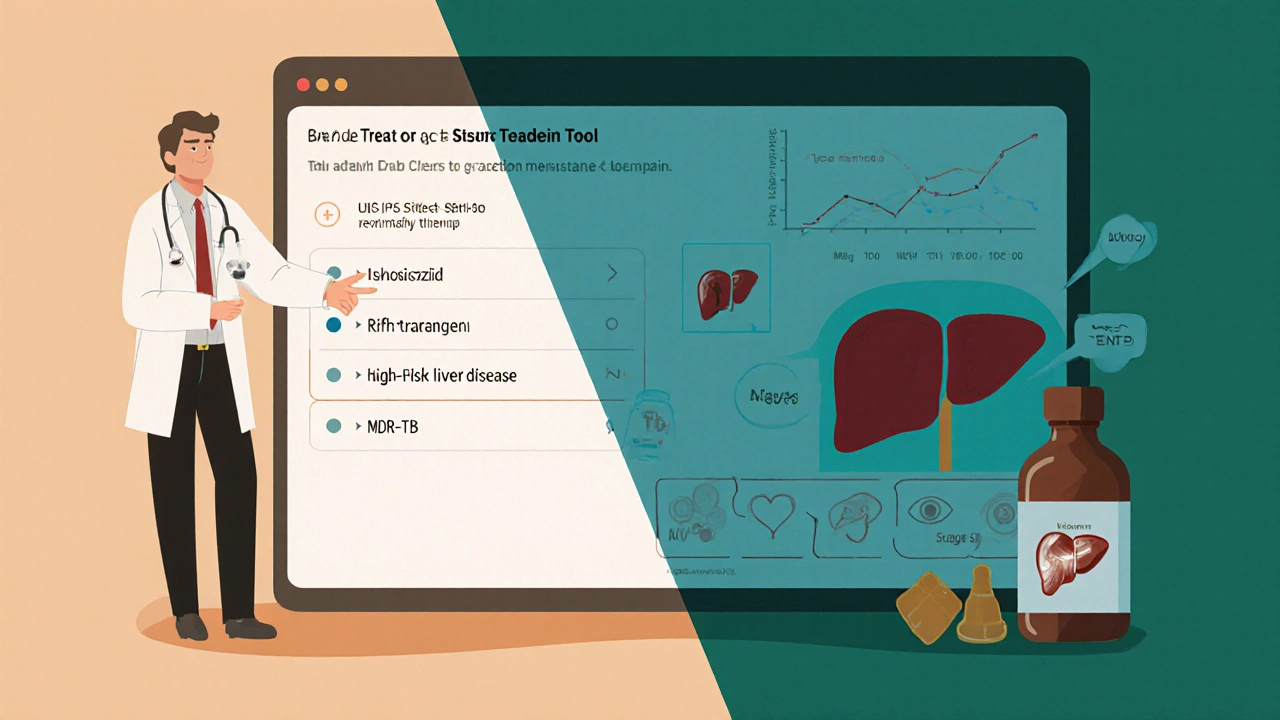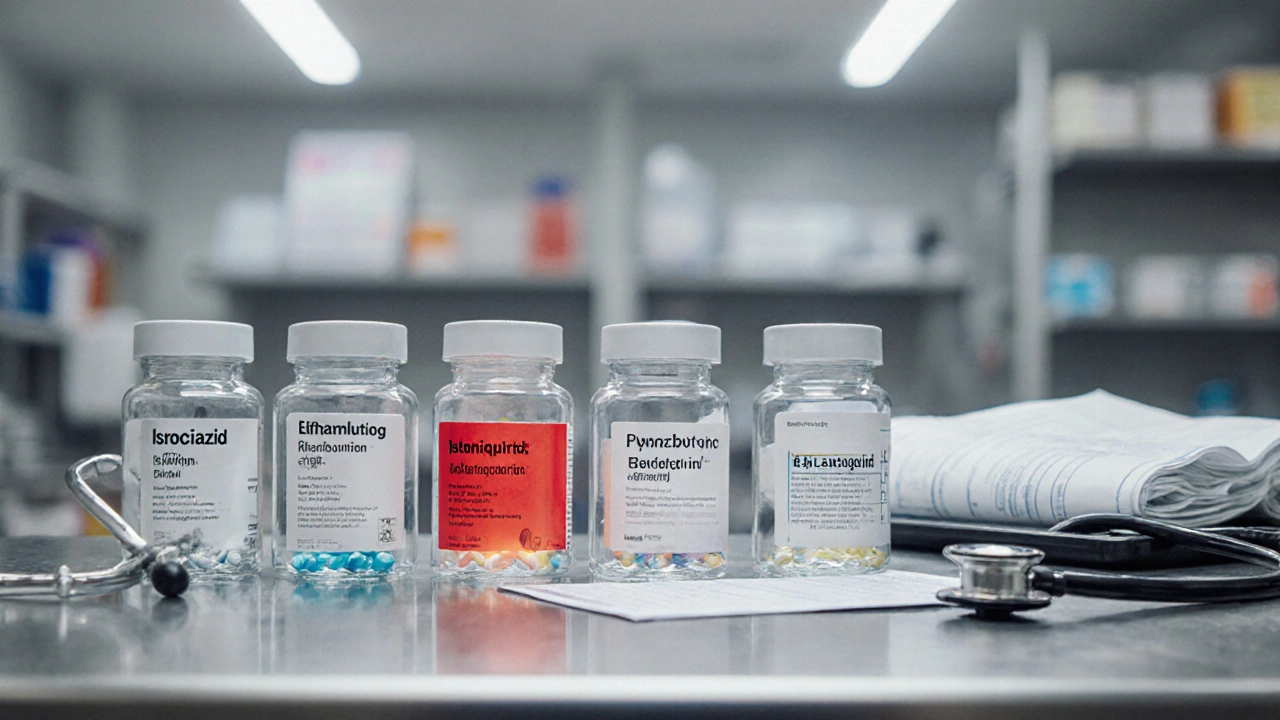TB Drug Comparison Tool
Side Effects Overview
| Drug | Common Side Effects | Serious Risks |
|---|---|---|
| Isoniazid | Transient nausea, headache, peripheral neuropathy | Hepatotoxicity, severe liver injury |
| Rifampin | Orange body fluids, mild GI upset | Hepatotoxicity, strong inducer of CYP450 |
| Ethambutol | Blurred vision, rash | Optic neuritis leading to permanent vision loss if untreated |
| Pyrazinamide | Gout flares, nausea | Severe hepatotoxicity, hyperuricemia |
| Bedaquiline | QT prolongation, nausea | Cardiac arrhythmia, hepatotoxicity |
| Delamanid | Headache, dizziness | QT prolongation, hepatic dysfunction |
When treating active tuberculosis, Isoniazid is a first‑line oral antibiotic that blocks mycolic acid synthesis in Mycobacterium tuberculosis. It’s been a cornerstone of TB therapy since the 1950s, but clinicians often wonder whether another drug might work better for a particular patient. This article walks through the most common alternatives, points out where each shines, and helps you decide which regimen fits a given clinical picture.
What makes Isoniazid a go‑to drug?
Isoniazid (INH) is prized for three reasons:
- High early bactericidal activity - it rapidly reduces the bacterial load in the first two weeks of therapy.
- Simple once‑daily dosing - most adults take 300mg (or weight‑based 5mg/kg) in a single daily tablet.
- Low cost - generic versions are typically under £1 per month in the UK.
Its downsides include liver toxicity, especially in older adults or those drinking alcohol, and a risk of peripheral neuropathy that can be mitigated with vitamin B6 supplementation.
Key alternatives to consider
Below are the main drugs you’ll see paired with or swapped for Isoniazid in modern regimens.
Rifampin is a broad‑spectrum antibiotic that inhibits RNA synthesis in Mycobacterium tuberculosis. It’s usually given at 600mg daily for adults and is essential in both standard 6‑month regimens and shorter 4‑month protocols.
Ethambutol works by disrupting cell‑wall formation and is given at 15mg/kg daily. It’s added mainly to prevent resistance when susceptibility is unknown.
Pyrazinamide is a pro‑drug that becomes active in acidic environments, targeting dormant bacilli. The typical adult dose is 20-25mg/kg daily for the first two months of treatment.
Streptomycin is an injectable aminoglycoside that interferes with protein synthesis. It’s reserved for multi‑drug‑resistant (MDR) cases or when oral options are limited.
Bedaquiline is a newer diarylquinoline that inhibits the ATP synthase of Mycobacterium tuberculosis. Approved for MDR‑TB, it’s dosed 400mg daily for two weeks, then three times per week.
Delamanid is a nitro‑imidazole that blocks mycolic acid synthesis, similar to Isoniazid but with a different enzymatic target. Used in MDR‑TB, the adult dose is 100mg twice daily.
Each alternative brings its own side‑effect profile, drug‑interaction concerns, and cost considerations.
Side‑effect snapshot
| Drug | Typical Side‑effects | Serious Risks |
|---|---|---|
| Isoniazid | Transient nausea, headache, peripheral neuropathy | Hepatotoxicity, severe liver injury |
| Rifampin | Orange body fluids, mild GI upset | Hepatotoxicity, strong inducer of CYP450 (affects many meds) |
| Ethambutol | Blurred vision, rash | Optic neuritis leading to permanent vision loss if untreated |
| Pyrazinamide | Gout flares, nausea | Severe hepatotoxicity, hyperuricemia |
| Streptomycin | Injection site pain | Ototoxicity, nephrotoxicity |
| Bedaquiline | QT prolongation, nausea | Cardiac arrhythmia, hepatotoxicity |
| Delamanid | Headache, dizziness | QT prolongation, hepatic dysfunction |
Drug‑interaction landscape
Understanding interactions helps avoid treatment failures. Isoniazid is a mild inhibitor of CYP2C19 and CYP3A4, meaning it can raise levels of certain antiretrovirals and anticonvulsants. Rifampin, on the other hand, is a potent CYP450 inducer, slashing concentrations of warfarin, oral contraceptives, and many HIV drugs. Bedaquiline and Delamanid share QT‑prolonging potential, so they should never be combined with other QT‑extending agents like fluoroquinolones without close ECG monitoring.

When to choose Isoniazid versus an alternative
Here’s a quick decision guide:
- Newly diagnosed drug‑susceptible TB - Standard 6‑month regimen (INH+Rifampin+Ethambutol+Pyrazinamide) works for >95% of patients.
- High risk of liver disease - Replace INH with Rifampin‑only intensive phase, add Streptomycin if resistance is a concern.
- Known INH resistance - Use Rifampin+Ethambutol+Pyrazinamide, consider adding Fluoroquinolone (e.g., Levofloxacin) for a longer intensive phase.
- MDR‑TB (resistant to INH and Rifampin) - Build a regimen with Bedaquiline, Delamanid, a later‑generation Fluoroquinolone, and an injectable like Streptomycin.
- Pregnancy - Isoniazid is generally safe; Rifampin is also acceptable. Avoid Streptomycin due to ototoxicity risk to the fetus.
These scenarios illustrate that Isoniazid remains valuable, but the right choice balances resistance patterns, patient comorbidities, and drug‑accessibility.
Monitoring and follow‑up
For anyone on Isoniazid, baseline liver function tests (ALT/AST) are a must, with repeat testing at month 1 and month 2. Patients over 35years or those consuming alcohol regularly need more frequent checks. Vitamin B6 (pyridoxine) 25mg daily prevents neuropathy in high‑risk groups. With Rifampin, monitor for drug‑level drops of co‑prescribed meds. Bedaquiline and Delamanid require baseline and monthly ECGs to watch QT intervals.
Cost and accessibility snapshot
In the UK, Isoniazid and Rifampin are funded under the NHS TB program, making them essentially free for patients. Ethambutol and Pyrazinamide are similarly covered. Bedaquiline and Delamanid are newer and can be pricey (≈£1,200‑£1,500 for a full course), but they’re available through specialty pharmacies for MDR‑TB cases.
Bottom line: the Isoniazid comparison you needed
If you’re dealing with standard, drug‑susceptible TB, Isoniazid stays the cheapest, most effective backbone. When liver health is shaky, resistance looms, or the disease is multi‑drug‑resistant, you’ll need to lean on Rifampin, Ethambutol, or the newer agents. Always pair the drug choice with the right monitoring plan, and remember that drug interactions can make or break a regimen.
Frequently Asked Questions
Can I take Isoniazid with alcohol?
Occasional light drinking is generally tolerated, but heavy or chronic alcohol use dramatically raises the risk of liver injury. If you drink more than two units a day, discuss liver‑function monitoring with your doctor.
Why is vitamin B6 given with Isoniazid?
Isoniazid can deplete pyridoxine, leading to peripheral neuropathy. A daily 25mg dose of pyridoxine prevents numbness and tingling, especially in diabetics and pregnant women.
What makes Bedaquiline different from Isoniazid?
Bedaquiline targets ATP synthase, a distinct bacterial enzyme, giving it activity against strains resistant to Isoniazid and Rifampin. It’s reserved for MDR‑TB and requires cardiac monitoring.
Is it safe to use Isoniazid during pregnancy?
Yes, most guidelines list Isoniazid as safe in all trimesters, provided pyridoxine supplementation is given. It helps prevent congenital TB, which can be fatal.
How long does a typical Isoniazid course last?
For latent TB infection, a 6‑month daily regimen (INH+pyridoxine) is common. For active disease, Isoniazid is part of a 6‑month combination therapy, with the drug given throughout.


Andrea Dunn
October 5, 2025 AT 02:17They don't want you to know the real side effects 😒
Sunthar Sinnathamby
October 8, 2025 AT 02:46Balancing the efficacy of isoniazid with its hepatotoxic risk is crucial. In standard TB cases, the drug’s early bactericidal activity saves lives. However, you must watch liver enzymes closely, especially in patients over 35 or with alcohol use. Adding pyridoxine can prevent peripheral neuropathy, a simple yet often overlooked step. The regimen’s low cost makes it unbeatable for most health systems. Stay vigilant, and you’ll keep the cure effective.
Catherine Mihaljevic
October 11, 2025 AT 03:15Isoniazid works but it’s not a miracle drug it can wreck the liver if you’re not careful
Callum Smyth
October 14, 2025 AT 03:45Great rundown! 👍 Remember to schedule monthly liver function tests and keep pyridoxine handy – it’s a small step that prevents big problems. If a patient shows any jaundice, pause the therapy and re‑evaluate. Keep the communication open with the care team and the patient – that’s how you stay ahead of side‑effects.
Kyle Salisbury
October 17, 2025 AT 04:14From a cultural perspective, the accessibility of isoniazid in low‑resource settings cannot be overstated. Its affordability enables community‑based programmes to reach remote areas where newer agents are unavailable. While newer drugs offer advantages, they often come with higher costs and monitoring requirements that many clinics cannot meet.
Emmons Kimery
October 20, 2025 AT 04:43Everyone, let’s remember that treatment isn’t just about pills 😊. Integrating nutritional support and patient education boosts adherence. When you combine isoniazid with proper vitamin B6 supplementation, you reduce neuropathy risk dramatically. And don’t forget to involve family members – they can spot early signs of toxicity.
Mimi Saki
October 23, 2025 AT 05:13👍 Keep up the good work, team! Positive vibes and proper monitoring make the difference.
Subramaniam Sankaranarayanan
October 26, 2025 AT 05:42Isoniazid remains the backbone of first‑line TB therapy for a reason. Its mechanism of blocking mycolic acid synthesis is both potent and well‑characterised. The drug’s pharmacokinetics allow once‑daily dosing, simplifying adherence for most patients. However, the hepatotoxic potential cannot be ignored, especially in populations with high rates of viral hepatitis. Studies have shown that baseline ALT levels above two times the upper limit predict a higher likelihood of severe injury. Age is another factor; patients over 50 experience a three‑fold increase in liver enzyme elevation. Alcohol consumption synergises with isoniazid, amplifying the risk of fulminant hepatitis. Genetic polymorphisms in NAT2 influence acetylation speed, making some individuals fast acetylators and others slow, which affects toxicity profiles. Co‑administration with other hepatotoxic drugs, such as pyrazinamide, compounds the danger. Despite these concerns, the cost‑effectiveness of isoniazid is unmatched, especially in resource‑limited settings. Its inclusion in the standard six‑month regimen yields cure rates above 95 % when combined with rifampin, ethambutol, and pyrazinamide. For latent TB infection, a six‑month daily course of isoniazid alone provides a 90 % reduction in progression to active disease. Vitamin B6 supplementation mitigates peripheral neuropathy, a side‑effect that can be debilitating if left unchecked. Regular monitoring-baseline, one month, and two months-allows early detection of hepatic injury. Clinicians should counsel patients on the signs of liver dysfunction, such as jaundice, dark urine, and abdominal pain, and advise immediate cessation if these appear. In summary, the benefits of isoniazid outweigh the risks when used judiciously with appropriate safeguards.
shawn micheal
October 29, 2025 AT 06:11That’s a solid overview, but you’re glossing over the fact that many patients can’t afford the routine LFT monitoring you demand; the reality on the ground is harsher.
John Hoffmann
November 1, 2025 AT 06:41Correction: “Isoniazid’s mechanism of action” should be written with an apostrophe, and “six‑month” needs a hyphen. Also, “pyrazinamide” was misspelled earlier as “pyrizinamide”.
Shane matthews
November 4, 2025 AT 07:10Good points overall. Just a reminder to keep the language consistent – use “hepatotoxicity” throughout instead of switching between “liver injury” and “hepatotoxic risk”.
Rushikesh Mhetre
November 7, 2025 AT 07:39Wow!!! This thread is on fire!!! 🚀 Let’s keep sharing these detailed breakdowns – knowledge is power!!! 🌟
Halid A.
November 10, 2025 AT 08:09In clinical practice, the integration of pharmacogenomic testing for NAT2 acetylator status could personalize isoniazid dosing and potentially reduce adverse events.
Vaibhav Sai
November 13, 2025 AT 08:38Absolutely brilliant! 🌈 Your insight shines like a lighthouse in the fog of TB treatment complexities!!! 🧭
Crystal Heim
November 16, 2025 AT 09:07Isoniazid is over‑hyped; newer drugs are clearly superior.
Sruthi V Nair
November 19, 2025 AT 09:37When we chase cure, we must also honor the patient’s journey, balancing science with compassion; only then does treatment become truly healing.